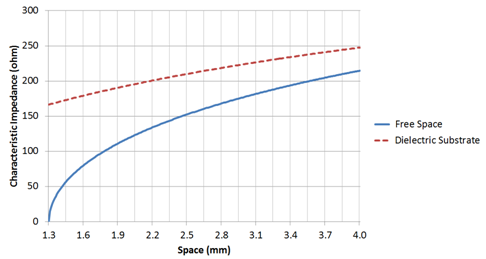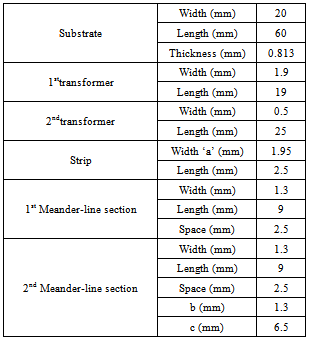-
Paper Information
- Previous Paper
- Paper Submission
-
Journal Information
- About This Journal
- Editorial Board
- Current Issue
- Archive
- Author Guidelines
- Contact Us
International Journal of Electromagnetics and Applications
p-ISSN: 2168-5037 e-ISSN: 2168-5045
2013; 3(2): 27-34
doi:10.5923/j.ijea.20130302.04
Design, Fabrication, and Characterization of a Dual-BandElectrically Small Meander-line Monopole Antenna for Wireless Communications
C. C. Hsu, H. H. Song
Department of Electrical and Computer Engineering, University of Colorado, 1420 Austin Bluffs Parkway, Colorado Springs, CO 80918 United States
Correspondence to: H. H. Song, Department of Electrical and Computer Engineering, University of Colorado, 1420 Austin Bluffs Parkway, Colorado Springs, CO 80918 United States.
| Email: |  |
Copyright © 2012 Scientific & Academic Publishing. All Rights Reserved.
Acompact, planar, dual-band meander-line monopole antenna that operates in frequency range of 2.400-2.480, 5.150-5.350, and 5.725-5.825 GHz was designed, fabricated, and characterized. Theoretical analysis based on the antenna theory was conducted to obtain the optimum characteristics.A 3-D electromagnetic finite-element solver, high frequency structure simulator (HFSS), was used in antenna simulation. The antenna was fabricated on a Rogers RO4003C substrate with dielectric constant of 3.38 and loss-tangent of 0.002 at 10 GHzand thickness of 0.813 mm. In 2.400-2.480 band, gain of 1.6 dBi and -10 dB frequency bandwidth of 11% were measured. In 5.150-5.350 and 5.725-5.825 bands, gain of 4.3 and 3.9 dBi with 1.14 GHz -10 dB bandwidth were measured. Omnidirectional radiation pattern was obtained for 2.400-2.480 band and double end-fire patterns were observed for 5.150-5.350 and 5.725-5.825 bands. The proposed antenna can be potentially used forportable wireless communication applications.
Keywords: Meander Line Antenna, Electrically Small Antenna
Cite this paper: C. C. Hsu, H. H. Song, Design, Fabrication, and Characterization of a Dual-BandElectrically Small Meander-line Monopole Antenna for Wireless Communications, International Journal of Electromagnetics and Applications, Vol. 3 No. 2, 2013, pp. 27-34. doi: 10.5923/j.ijea.20130302.04.
Article Outline
1. Introduction
- Compact dual band antennas are required for various applications including wireless local area network (WLAN). Recent WLAN communication systems support 2.4/5.0 GHz band such as IEEE 802.11a/b/g/n standard.The 2.4/5.0 GHz band utilizes frequency ranges of 2.400-2.480,5.150-5.350, and 5.725-5.825 GHz in US.In order to support the increasing need for compact antennas for WLAN communication systems, an electrically small antenna (ESA) has been a subject of great interest[1-4]. In the past decade, portable communication devices have provided an opportunity of using electrically small antennas (ESAs) with highly integrated RF circuit design.One of the promising ESA structures is the meander-line configuration. It is compact in size and provides wide bandwidth suitable for dual-band operation. Studies on meander-line ESAs were reported. A 700 MHz single-band meander-line ESA was investigated for RFID-tags applications [5]. In this work, the high permittivity substrate and the meander-line configuration improved the inherent deficiencies of low radiation efficiency and low gain of the ESAs.Studies on the2.4 GHz printed meander-line antennaswere reported for WLAN applications [6]-[7]. Dual-band meander-line ESAs for 1.4/2.4 and 2.4/5.0 GHz bands were reported for GSM/DCS,Bluetooth, and WLAN applications [8]-[11]. However, there still is a need for a meander-line antenna that can provide wider frequency bandwidth for 5.0 GHz band.In this paper, we propose a compact, dual-band meander-line ESA for WLAN applications. The proposed antenna consists of two meander-line sections, a conducting strip [12]-[13], and a micro-strip matching network. The antenna port impedance is designed to match a 50 Ω coaxial cable. For bandwidth increase in 5 GHz band, the conducting strip is applied within section space of the second meander-line section.By adjusting the dimensions of the second mender-line section and the conducting strip, theproposed antenna can provide the frequency bandwidth for a return-loss less than -10-dB is 11% and 1.14 GHz for 2.4 GHz and 5 GHz band, respectively.Compared to the previously reported results, the proposed antenna provides a particularly better coverage of frequency bandwidthfor 5.0 GHz band. The antenna design procedures, simulation and measurement results for return-loss, far-field radiation patterns, and antenna gain are presented.
2. Characteristics ofan ESA and a Meander-line Section
- The ESAs have fundamental limitations to their frequency bandwidth. Wheeler investigated this limitation and indicated that the maximum dimension of an ESA needs to be less than
 asshown in (1)[1]. In ESAs, higher antenna
asshown in (1)[1]. In ESAs, higher antenna  (resonance quality factor) introduces narrower frequency bandwidth.In order to obtain maximum bandwidth, another inherent characteristic that needs to be considered is the minimum
(resonance quality factor) introduces narrower frequency bandwidth.In order to obtain maximum bandwidth, another inherent characteristic that needs to be considered is the minimum  value. The minimum
value. The minimum  of the ESAs in free space and the gain can be expressed as (2) and (3), respectively [4], [2]. In (3),
of the ESAs in free space and the gain can be expressed as (2) and (3), respectively [4], [2]. In (3),  is the wavenumber in free space in radians/meter and
is the wavenumber in free space in radians/meter and is the maximum radius of enclosing sphere of the antenna in meter. The approximate impedance bandwidth in terms of
is the maximum radius of enclosing sphere of the antenna in meter. The approximate impedance bandwidth in terms of  is given by (4)[3]. Here
is given by (4)[3]. Here  is the VSWR and BW is the normalized bandwidth.
is the VSWR and BW is the normalized bandwidth. | (1) |
 | (2) |
 | (3) |
 | (4) |
 ,
,  , and
, and  is the complete elliptic integral of the first kind, and
is the complete elliptic integral of the first kind, and . The approximation for the function
. The approximation for the function  can be expressed as (6)[15] and the characteristic impedance of CPS is shown in (7)[16]. Here
can be expressed as (6)[15] and the characteristic impedance of CPS is shown in (7)[16]. Here  is given by (5). Assuming the CPS on a dielectric substrate is lossless, the input impedance of a meander-line section on a dielectric substrate is equal to a short-circuited transmission line on a dielectric substrate; the input impedance is given by (8)[17]. Here
is given by (5). Assuming the CPS on a dielectric substrate is lossless, the input impedance of a meander-line section on a dielectric substrate is equal to a short-circuited transmission line on a dielectric substrate; the input impedance is given by (8)[17]. Here  is phase constant of quasi-TEM mode in rad/m, and
is phase constant of quasi-TEM mode in rad/m, and  is the length of meander-line section in meter. If
is the length of meander-line section in meter. If  , the self-inductance of each meander-line section is given by (9)[17]. This inductive property compensates negative radiation reactance of an antenna of length less than a quarter-wavelength, as shown in Figure 3 [18].
, the self-inductance of each meander-line section is given by (9)[17]. This inductive property compensates negative radiation reactance of an antenna of length less than a quarter-wavelength, as shown in Figure 3 [18].  | (5) |
 | (6) |
 | (7) |
 | (8) |
 | (9) |
 | Figure 1. Geometry of a meander-line section |
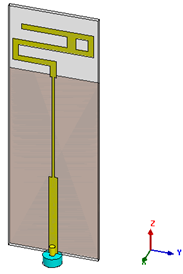 | Figure 2. HFSS 3D simulation model of the proposed meander-line monopole antenna. (Substrate: mm3) |
 | Figure 3. Radiation impedance of a finite length monopole antenna in free space with the resonant frequency of 2.45 GHz and the wire radius of 10-6 m |
3. Simulated Results and Measurement
- A close view of the meander line antenna section is shown in Figure 5. Figure 6 shows the S11 curve with ‘c’ dimension variation for fixed values of a=1.3 mm and b=1.3 mm.Figure 7 describes the S11response with‘a’ dimension variation for fixed values of c=6.5 mm and b=1.3 mm. The optimized dimensions obtained from the3-D simulation model of the proposed antenna are indicated in Table 1.Simulated gains of the proposed antenna in 2.4GHz (vertical orientation) and 5.0 GHz (horizontally lateral orientation) bands are shown in Figures 8 and 9, respectively.
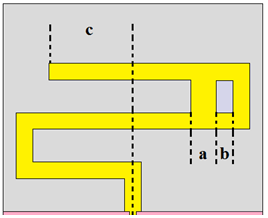 | Figure 5. Close view of the meander line antenna section of the proposed antenna |
|
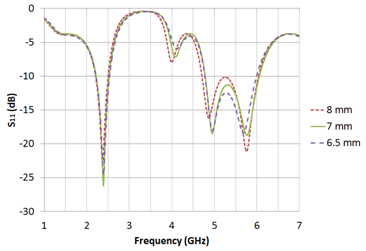 | Figure 6. The S11response of the proposed antenna with ‘c’ dimension variation for fixed values of a=1.3 mm and b=1.3 mm |
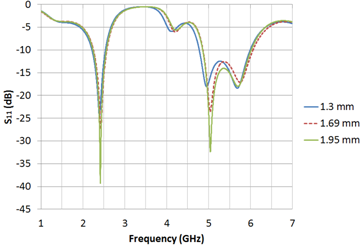 | Figure 7. The S11response of the proposed antenna with ‘a’ dimension variation for fixed values of c=6.5 mm and b=1.3 mm |
|
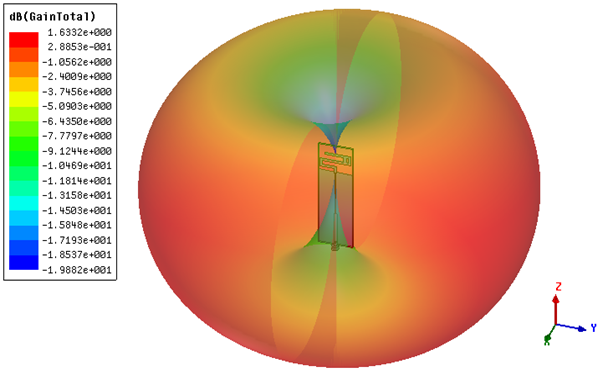 | Figure 8. Simulated gain of the proposed antenna at 2.45 GHz(vertical orientation) |
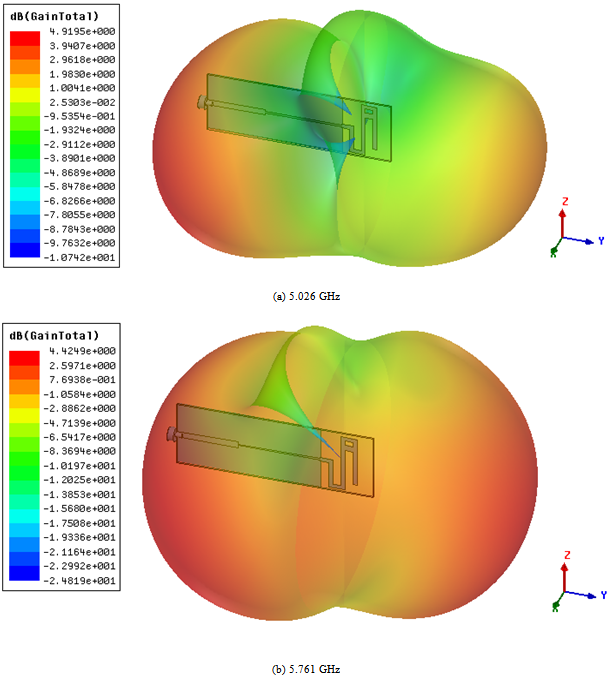 | Figure 9. Simulated gains of the proposed antenna in 5.0 GHz band (horizontally lateral orientation) |
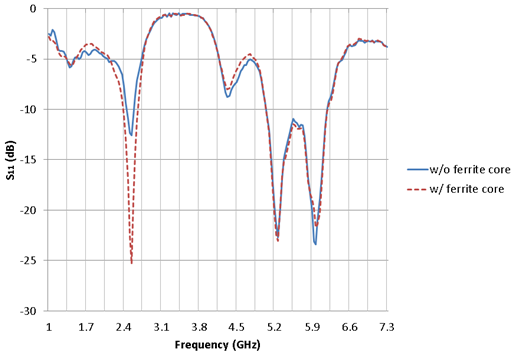 | Figure10. Measured S11 curve of the proposed antenna with and without the ferrite core |
 | Figure 11. Simulated and measured radiation patterns at 2.54 GHz on vertical orientation |
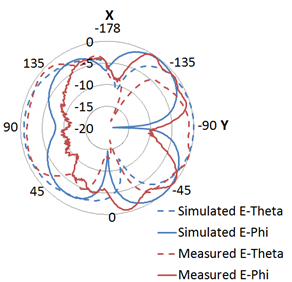 | Figure 12. Simulated and measured radiation patterns at 5.27 GHz on horizontallylateral orientation |
 | Figure 13. Simulated and measured radiation patterns at 5.977 GHz on horizontallylateral orientation |
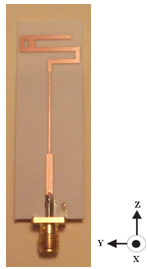 | Figure 14. Fabricated dual-band meander-line monopole antenna |
4. Summaries and Conclusions
- In this paper, a design, fabrication, and characterization of a planar dual-band meander-line monopole antenna are presented. The proposed antenna is compact in size,
 mm3, and operates in dual band, 2.4/5.0 GHz,to support WLAN systems. The measured resonant frequencies were within 200 MHz difference compared to the simulated results.The proposed antenna showed 1.6 dBi measured gain and11% -10-dB frequency bandwidthin 2.4 GHzband ina vertical orientation. In 5.150-5.350 and 5.725-5.825 bands, measured gain of 4.3 and 3.9 dBiwere obtained with 1.14 GHz -10-dB frequency bandwidth in a horizontally lateral orientation. An omnidirectional pattern was obtained in 2.4 GHzband and a double end-fire pattern was obtained in the 5.0 GHz band. The proposed antenna can be potentially used for portable WLAN communication devices.
mm3, and operates in dual band, 2.4/5.0 GHz,to support WLAN systems. The measured resonant frequencies were within 200 MHz difference compared to the simulated results.The proposed antenna showed 1.6 dBi measured gain and11% -10-dB frequency bandwidthin 2.4 GHzband ina vertical orientation. In 5.150-5.350 and 5.725-5.825 bands, measured gain of 4.3 and 3.9 dBiwere obtained with 1.14 GHz -10-dB frequency bandwidth in a horizontally lateral orientation. An omnidirectional pattern was obtained in 2.4 GHzband and a double end-fire pattern was obtained in the 5.0 GHz band. The proposed antenna can be potentially used for portable WLAN communication devices.  Abstract
Abstract Reference
Reference Full-Text PDF
Full-Text PDF Full-text HTML
Full-text HTML